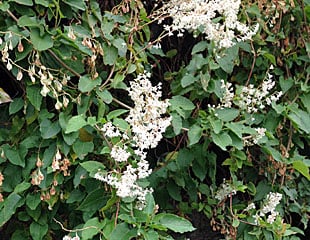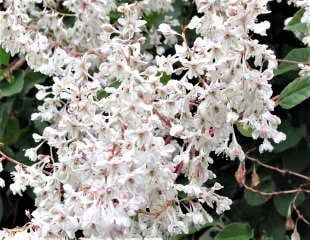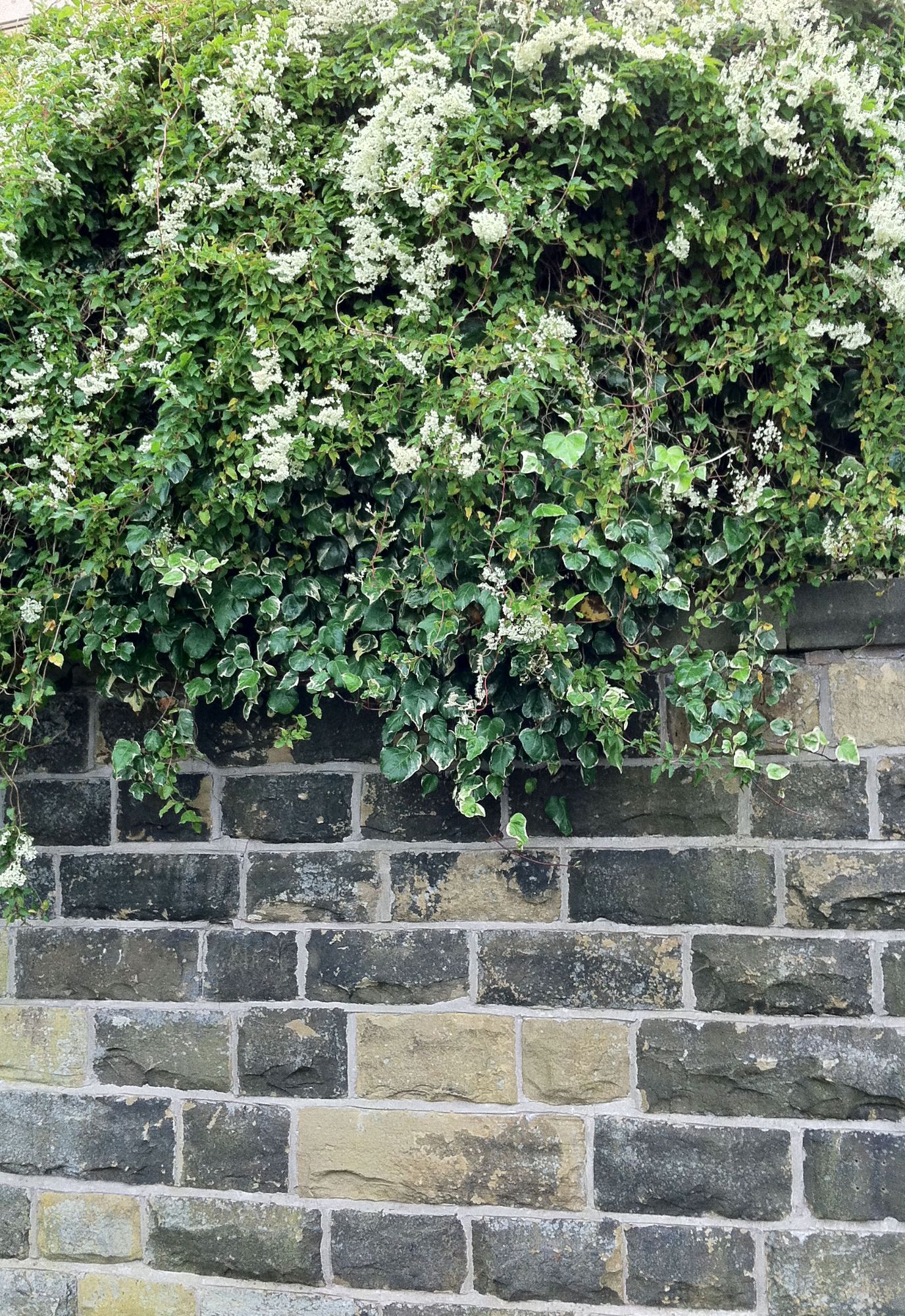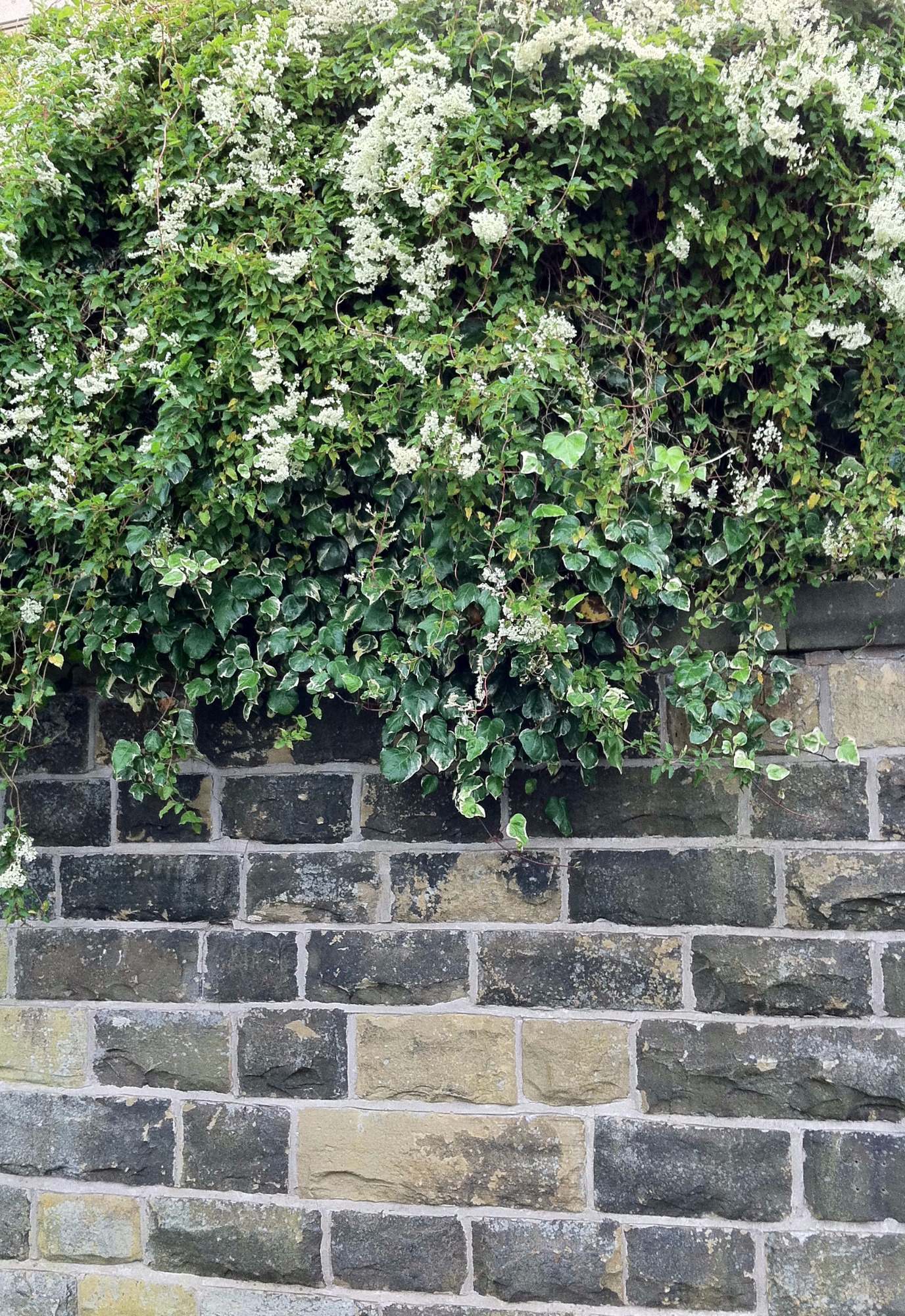

How to Grow Fallopia Also known as Russian Vine and 'Mile A Minute Plant'

Key Points
1. Fully Hardy
2. Tolerant of all growing conditions - Grow anywhere
3. Very vigorous and regarded as rampant
4.Likely to smother other plants best grown on its own
5. Plant with caution.
About Fallopia baldschuanica also known as Russian vine
Fallopia baldschuanica which is also known as Russian Vine, and Mile a Minute plant, is very easy to grow, so easy you cannot stop it and it is invasive. This climber is very vigorous. In reality, it can be rampant and hard to control. Ideal if you have a large space or structure you want to cover, but it comes with a gardening health warning as it grows quickly and can easily outgrow its welcome.
On the plus side, as the images show, it has lovely delicate flowers and attractive foliage. It is a deciduous climbing plant, which means it is not evergreen and drops its leaves in the autumn. It looks good trailing over walls, as shown in the image .
It is so invasive it will out compete anything in its way, scrambling its way to the top. It also has shoots which will not only twine but can force their way into cracks and spaces. This means if Russian Vine is grown over a structure, such as a shed, it can find its way into the building, which is destructive to the structure and can cause problems.

How to grow Fallopia baldschuanica
It is very easy to grow, try stopping it; Russian Vine will grow almost anywhere, although Fallopia do prefer sun where it will flower best, and planted in well-drained soil. It is tolerant of semi shade, and of poor soil, and it is fully hardy down to H7. A rich soil will tend to produce more leaves than flowers. From this, you can rightly guess it will grow pretty well anywhere.
In terms of how to grow Fallopia, it is really a case of plant it and watch it grow. It is self supporting by its tendrils. When newly planted, like all new plants, water it well to ensure it does not dry out. It will grow up to 12m which is around 40ft.
It belongs to the pruning group 11 and should be pruned in early Spring during February or March. Like all pruning, it should be undertaken on a frost free day and cut back as necessary to try to keep it to its allotted space. However, it would be hard work and optimistic to think that regular annual pruning would keep a Russian Vine in check. They're not enough pruning hours in the day, bearing in mind it can grow 12 meters in a season. It makes Wisteria look timid. Its size and fast growth means that it is a climber that you only plant if you really need this type of plant. I once inherited a Fallopia which grew over a not very well maintained out building, into which the vine quickly forced its tendrils and within a short time the building became even less well maintained.
The Russian Vine, in common with some other vigorous, climbing plants, can cause damage to structures. It can easily grow into and force its way through cracks and, by this route, enter the fabric of a building and cause damage. Equally, if you have a structure that you want to hide, although deciduous, the Russian Vine will quickly do this. It is a woody climber which once established has very significant roots and thus not easy to remove if you decided it's the wrong plant.
Still fancy planting it in your garden. You can buy online from Suttons who have several pot sizes available.
Still looking for the ideal climbing plant? Take a look at Climbing plants for ideas on all sorts of climbing plants including detailed advice on Clematis. On this and other pages there are images and growing advice for many popular climbing plants such as Wisteria, Honeysuckle, Passion flower, Ivy and many more.
Just how Quickly Fallopia /Mile a minute /Russian vine grows
To illustrate just how vigorous and smothering this vine can be, I have two images taken in 2015 and 2022. In 7 years, the Russian vine has gone from trailing nicely over the wall, to smothering the wall and adjacent building which happens to be empty, hence the vine has been left unchecked.
Russian Vine growing over a wall in 2015

Here it looks well behaved
Same vine same place 2022

In this image, you can see the Russian vine has covered the wall, travelled across the gap and up into the adjacent (empty) building and is all over it climbing onto the roof. It has completely taken over the space and is likely to be in the structures.
How to get rid of Fallopia the Mile a minute plant/Russian vine
If you inherit a "Mile a minute plant" and want to get rid of it, there are two basic ways. If you garden organically, it is the hard work route, firstly chopping it down and removing all traces. Then you have to dig out the root completely to stop it coming back.
The alternative is to try to kill it with a weedkiller. Previously, that would have been a weed killer typically containing Glyphosate, which used to be found in many weed killers such as "Roundup". As gardeners we strive not to have a negative impact on our environment and there is a respected body of research to show that Glyphosate is directly damaging to pollinators and our endangered bees, it can kill the earthworms in the soil and cause damage via the water table. It is banned in many countries around the world, but sadly not yet the UK, but it should be avoided at all costs. Either dig out the vine, or take a look at the various glyphosate free products.
Last updated 16.01.2024
RHS Award of Garden Merit

RHS Award of Garden merit indicates plants tried and testing by the RHS and are usually good varieties to purchase. The variety F.baldschuanica has the RHS garden merit award.
It can Look good trailing over a lwall

Green wheelbarrow plant

Green Wheelbarrow shows that a plant is easy to grow and requires no maintenance.
